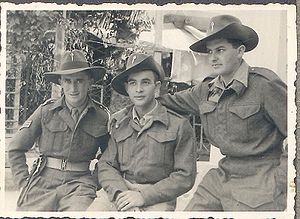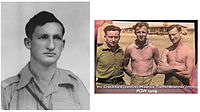- Special Interrogation Group
-
The Special Interrogation Group (SIG) (some sources interpret this acronym as Special Identification Group or Special Intelligence Group) was a unit of the British Army during World War II. It was organized from German-speaking Jewish volunteers from the British Mandate of Palestine. The SIG performed commando and sabotage operations against Axis forces during the Western Desert Campaign.
Contents
Formation
The idea to create the SIG belonged to Herbert Cecil A. Buck, MC of the Punjabi Guards and Scots Guards.[1] , an Oxford scholar and German linguist who was captured and escaped from Egypt using German uniform. He subsequently became the SIG commander.
In March 1942, Col. Terence Airey (Military Intelligence Research at the War Office in London) wrote that "a Special German Group as a sub-unit of M[iddle] E[ast] Commando... with the cover name 'Special Interrogation Group', to be used for infiltration behind the German lines in the Western Desert, under 8th Army... the strength of the Special Group would be approximately that of a platoon... The personnel are fluent German linguists... mainly Palestinian (Jews) of German origin. Many of them have had war experience with No. 51 Commando..." [2]
Some personnel was also recruited directly from the Palmach, Haganah and the Irgun. Other recruits came from the Free Czech Forces, the French Foreign Legion and German-speaking Jewish troops. The SIG was a part of D Squadron, First Special Service Regiment. Its strength varied between 20 and 38, according to various sources.[2]
Training
According to ex-SIG member Maurice "Tiffen" Monju Tieffenbrunner, their first training base was located near Suez.[2] The SIG were trained in desert navigation, unarmed combat, handling of German weapons and explosives. They were given fake German identities and taught German marching songs. For their missions, they were supplied with German pay books, cigarettes, chocolates, and even love letters to fictitious sweethearts in Germany.
Walter Essner and Herbert Brueckner, two non-Jewish Germans, had been conscripted from a POW camp to train the SIG. Before the war, both had been members of the French Foreign Legion who had been captured in November 1941 serving in the 361st Regiment of the Afrika Korps and were subsequently recruited by the British Combined Services Detailed Interrogation Centre (CSDIC) as double agents.
Operations and betrayal
On June 3, 1942, the SIG was assigned its first mission: Operation Agreement to assist the Special Air Service, led by Lt. Col. David Stirling in destroying Luftwaffe airfields which were threatening the Malta Convoys. These airfields were located 100 miles west of Tobruk in the Italian colony of Libya.
The SIG drove captured German vehicles behind German lines near Bardia, set up roadblocks and carried out acts of sabotage. Dressed as German military police, they stopped and questioned German transports, gathering important military intelligence.
During one raid, Herbert Brueckner managed to run away and betrayed them. Essner, closely guarded by Tiefenbrunner throughout the raid, was handed over to the Military Police and later shot.[3]
Disbandment
On September 13-14, 1942, the SIG participated in Operation Agreement, the raid on Tobruk. Its objective was to destroy the Afrika Korps' vital supply port. The SIG were to play the role of German guards transporting three truckloads of British POWs to a camp at Tobruk. The assault failed and the British forces lost three ships and several hundred soldiers and Marines. Surviving SIG members were transferred to the Auxiliary Military Pioneer Corps.
Tiefenbrunner account of SIG
In January 1999, Maurice (Monju) Tiefenbrunner, a surviving member of SIG, recorded his life story in an unpublished autobiography booklet called "A Long Journey Home". On pages 37–41, he provides information on SIG unit formation and operations. A sample scan of the first pages is shown to the right.
After the SIG was disbanded, Tiefenbrunner was caught by the Italians, and sent to a POW camp in Italy. He was moved to a POW camp in Nazi German territory, where he met Vic Crockford.[4] They were released in early 1945.
Partial list of SIG members
- Herbert Cecil A Buck, MC
- Maurice "Tiffen" (Monju) Tiefenbrunner (formerly of the No. 51 Commando and SAS)
- Ariyeh Shai
- Dov Cohen (formerly No. 51 Commando, nicknamed "Shimshon" in the Irgun (Etzel), killed at the age of 32 in the aftermath of the Acre Prison Break in 1947 [5])
- Bernard Lowenthal
- Herbert Delmonte-Nietto-Hollander (attached from Tower Hamlets Rifles, now the London Regiment)
- Israel Carmi (later an officer in the Jewish Brigade)
- Karl Kahane (served in the regular German army for 20 years, had an Iron Cross from World War I, a Town Clerk in Austria until forced to flee after the Anschluss)[6]
- Dolph Zentner (No. 51 Commando)
- Philip [Shraga-Iser] Kogel (No. 51 Commando)
- Walter Essner (German POW)
- Herbert Brueckner (German POW)
Film
The 1967 film Tobruk was about a raid of the SIG and the LRDG (Long Range Desert Group) on a German Afrika Korps fuel depot in Tobruk, starring Rock Hudson and George Peppard.
See also
- Jewish Brigade
- Jewish partisans
- Jewish resistance under Nazi rule
References
- ^ John Bierman and Colin Smith (2002) The Battle of Alamein: Turning Point, World War II Viking p. 139
- ^ a b c The Jewish Commandos of the SIG by Martin Sugarman, BA (Hons), Cert Ed. - Assistant Archivist, Association of Jewish Ex-Servicemen and Women (AJEX) Jewish Military Museum. February 6, 2002 (The Allied Special Forces Association) Accessed July 9, 2006
- ^ Julian Kossoff, Mike Yared, The Times November 17, 2000 [1]
- ^ Vic Crockford account of his search for his POW camp comrade-friend Maurice Tiefenbrunner[2]
- ^ Acre Prison Break [3]
- ^ "Anders Lassen" by M Langley, New English Library, 1988 pp.199 and 210). For Kahane's SIG participation in the Benghazi raid of June 1942, see "Rogue warrior - Paddy Mayne", Bradford and Dillon, Arrow Books 1989 pp. 43-4 and Appendix 1 and "The Phantom Major", V Cowles, Collins 1958, pp.156-61 [4]
Further reading
- Martin Gilbert, The Jews in the Twentieth Century. An Illustrated History (Schocken Books, 2001) ISBN 0-8052-4190-6 p.218-220
Categories:- Special forces of the United Kingdom
- Jewish resistance during the Holocaust
- Jewish military units and formations
- British Commandos
Wikimedia Foundation. 2010.



